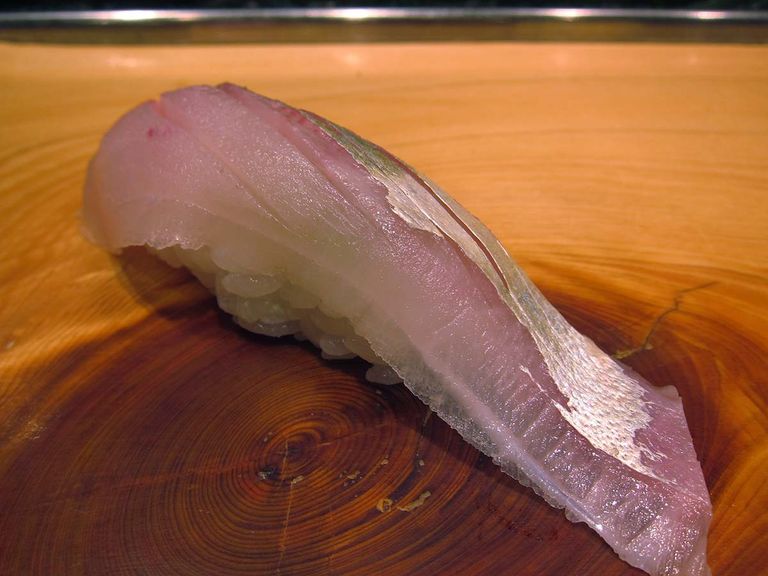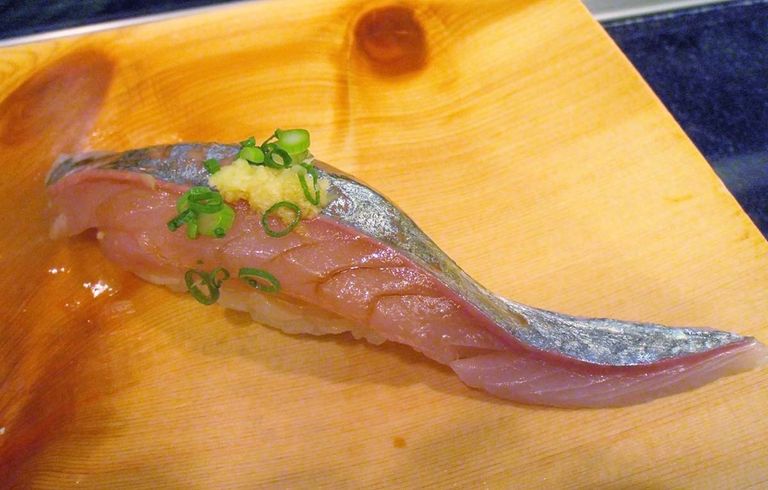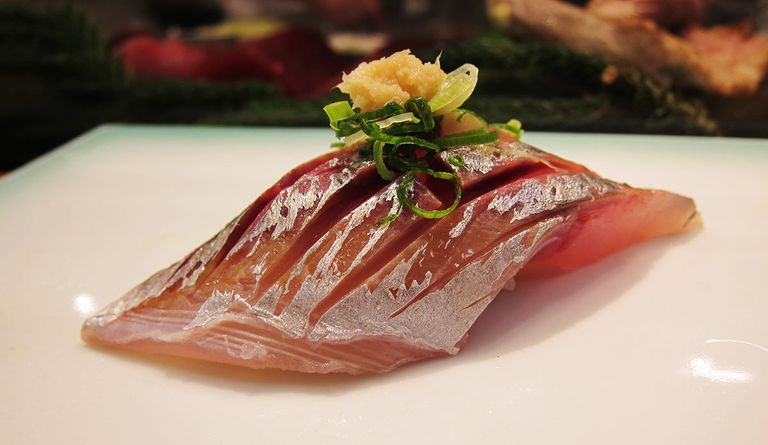Aji Sushi
A Comprehensive Overview of Jack Mackerel or Saurel in Japanese Sushi Cuisine
アジすし 、 鰺寿司 
What is Aji?
Aji アジ is the Japanese generic term for a group of fish from the spiny mackerel subfamily, which includes many species. In a gastronomic context, the term aji is usually associated with maaji, the Japanese horse mackerel (Trachurus japonicus). Although the term aji can be applied to any member of the Carangidae family that has the ending aji, this is not a common convention in general usage or in gastronomy. In gastronomy, aji typically refers to maaji. Historically, the term aji dates back to the Edo period. To distinguish maaji from other types such as maruaji or muroaji, modifiers such as ma 真 (genuine) or hon 本 (original) were added. This nomenclature emphasizes the maaji as an essential member of the aji family and points to its importance and frequent occurrence.[1]
Aji for Sushi or Sashimi
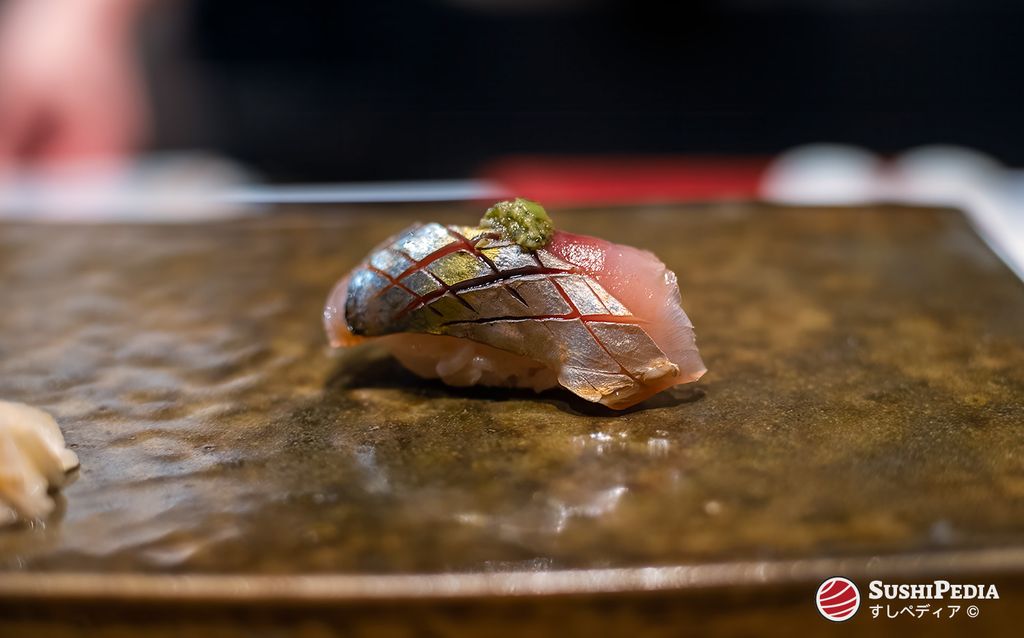
SushiPedia. Aji Nigiri Sushi. All rights reserved ©
Aji is one of the most important representatives of sushi ingredients prepared with the shiny silver skin (hikarimono). The meat of aji is pink and firm. It is also juicy, rich in fat and has a strong characteristic taste. Like other silver-skinned fish, aji is particularly tasty after salting and marinating in vinegar (sujime). Marinating not only preserves and absorbs strong flavors, but also serves to enrich aromas and reduce the “fishy” taste. Contrary to popular belief, soaking in a salt or vinegar solution does not sufficiently kill any parasites that may be present.
While the currently popular seki aji ... is coming to the tsukiji market, I want to make nigiri with aji (maaji), which is much smaller and tastes lighter.
Jiro Ono, Sushi Chef[2]
In high scale sushi restaurants, such as the famous Sukiyabashi Jiro in Tokyo by Jiro Ono, untreated raw aji is also preferred. According to Mr. Ono's statement, untreated raw aji is not only more difficult to process, but also makes higher demands on quality and freshness than if aji was marinated. It should be noted that the meat of aji can spoil very quickly due to its high enzyme content.[2]
Usually aji nigiri sushi is garnished with freshly grated ginger (oroshi shōga) and finely chopped spring onion (negi), together this creates an amazingly successful combination of flavors and is more suitable than Japanese horseradish (wasabi). This combination blends wonderfully with vinegared sushi rice. Soy sauce should only be used sparingly for glazing. The meat of aji is rich in omega-3 fatty acids and vitamins B2, B3, B6 and B12.
Best Season
The optimal season for catching horse mackerel, known as aji in Japanese cuisine, varies significantly between the Pacific and Atlantic oceans. In the Northeast Atlantic, Trachurus trachurus generally reaches peak fat content during the summer months, from August to October, with some evidence of a secondary peak in January along the Portuguese coast.
Mediterranean populations show more variation, with the highest fat in late winter to spring (peaking around March–April). Fat content fluctuates more dramatically in the Mediterranean species, which spawn in summer. For example, one study found muscle fat ranged from near-zero in late summer up to a few percent in spring.
For Pacific species, Trachurus japonicus in the Northwest Pacific tends to have higher fat content in summer and fall, while the limited data on Trachurus murphyi in the Southeast Pacific suggests potential peaks in approximately August–October. Japanese fishermen also recognize summer to early fall as the season of “oily” aji ideal for sushi. By late fall, the fish are still fairly rich, before winter scarcity sets in.
Trivia about Aji
The scientific genus name Trachurus comes from the Greek and means “rough tail” (from trachys for rough and oura for tail). This refers to the rough skin near the caudal fin peduncle of these fish.
Aji is known in English as Atlantic horse mackerel, a name derived from the old Dutch word Horsmakreel. The term refers to mackerel that spawn in shallow sea regions or near the coast, known as hors. The term was adapted by the English as “horse mackerel”, and in Norway the fish is known as heste makrel, heste being the Norwegian word for horse. In the past two decades, the name Paardenmakreel has appeared on the Dutch fish market, a retranslation of the English “horse” into the Dutch paard. It is still the same species of fish. A similar linguistic change can also be found in Portuguese. Another historical Dutch name for the horse mackerel is Maasbanker, which describes spawning in shallow areas of the North Sea, particularly near the River Maas. This name changed to Maasbangu in the Caribbean, but remained in Africa, especially in South Africa, and in Asia as Maasbanker. This name development reflects the influential role of the Netherlands in fishing and trade in the 16th and 17th centuries.[3]
Aji in Japan
In Japan, aji is an important ingredient in many dishes. Besides being used for sushi or sashimi, horse mackerel are often grilled, simmered, or fried. The fact that aji is highly appreciated as an ingredient in Japan is reflected by the fact that the Japanese kanji 味 (あじ) for “taste” or “flavor” is also read as aji in Japanese.
From the Strait of Bungo
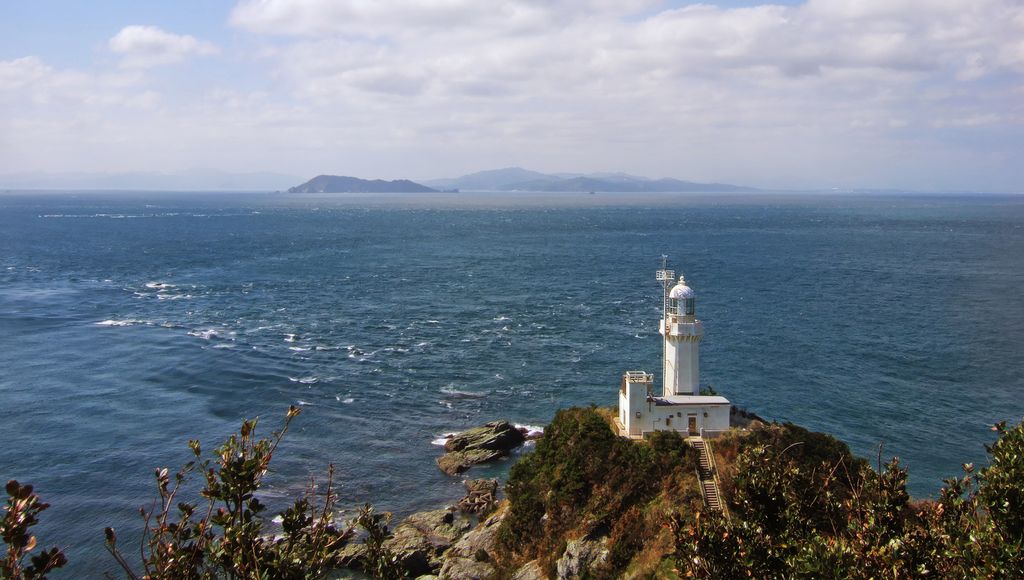
The Bungo Strait provides an ideal habitat for a variety of fish species thanks to its strong tidal currents, the mixture of warm and cold water and the rich supply of nutrients. The fish caught here are particularly sought after in Japanese cuisine, as they are prized for their exceptional freshness and outstanding quality.
hiroaki. Hōyo Strait. flickr.com. Some rights reserved: Creative Commons Attribution 2.0 Generic. Changes applied: crop, noise
In Japan, Japanese horse mackerel are called seki aji if their fishing area is in the Strait of Bungo 豊後水道. Only specimens caught off the coasts of Saganoseki City are allowed to be called seki aji. The meat is characterized by its balanced amount of fat and firm flesh. They are particularly popular in upscale sushi restaurants and are traded at correspondingly high prices.
Ecology of Aji
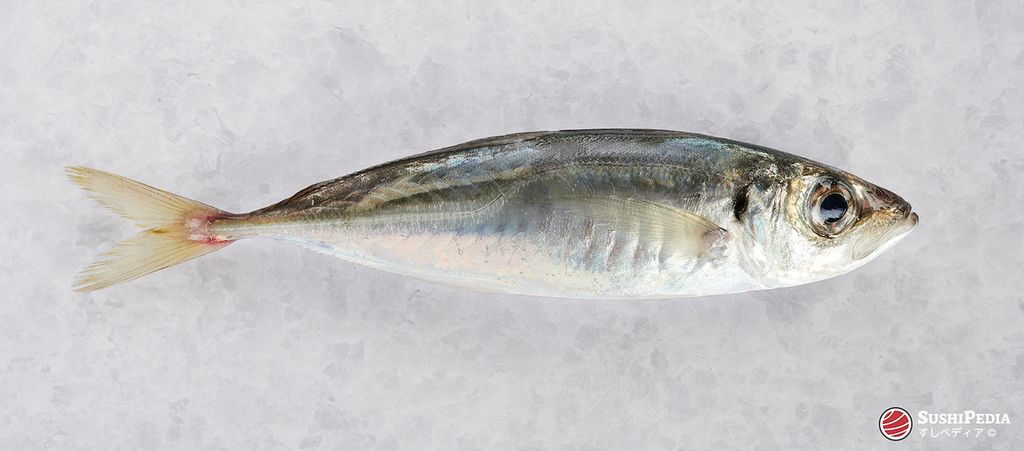
Unknown author. Aji (horse mackerel). All rights reserved ©
Many species categorized by the Japanese as belonging to the group of aji are native to tropical and temperate waters of the world. The most relevant species of this group for the preparation of sushi is the Japanese horse mackerel (maaji), whose range extends from Hokkaido to the South China Sea. In contrast, the most economically important species is the Chilean jack mackerel (chiri maaji). This is also used in Japan, along with related species from the North Atlantic and South Pacific, as a substitute (daiyōgyo) for the preparation of aji sushi. The closely related amberstripe scad (muroaji) is found primarily in tropical and subtropical waters and is also considered an important seafood in Japan.
Economy of Aji
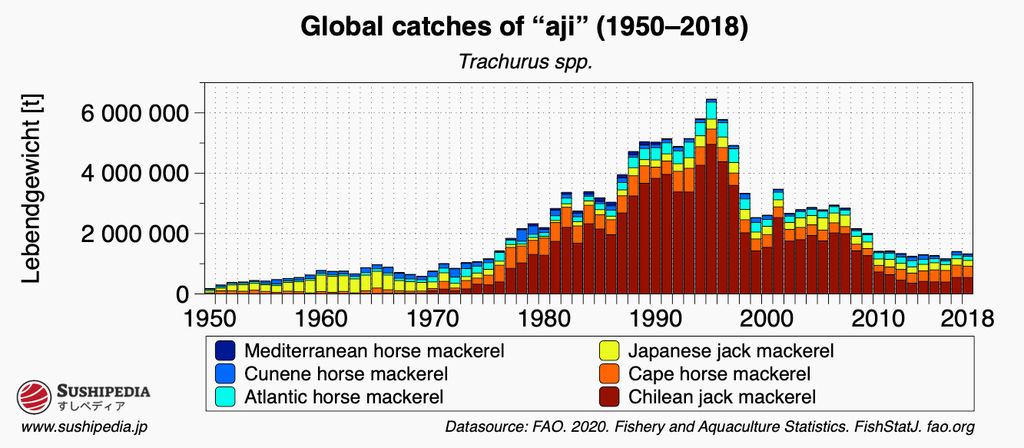
SushiPedia. Global Aji Catch in Metric Tons (2023) - FAO Data. All rights reserved ©
In commercial fisheries, historical catch data provides insights into the health of marine ecosystems and the sustainability of fishing practices. Data from the Food and Agriculture Organization of the United Nations (FAO) provides insight into global catches of aji, a collective name for various mackerel species of the genus Trachurus, over a period of nearly seven decades.
From 1950 to 2018, the stacked bar chart shows a significant increase in catches, starting at a low level and increasing dramatically in the 1970s and 1980s. The spikes in catches in these decades indicate a period of intense fishing activity, possibly driven by the growing demand for aji in the food industry, and the chart classifies catches by species: Mediterranean horse mackerel, Cunene horse mackerel, Japanese horse mackerel, Cape horse mackerel and Chilean horse mackerel. Each species contributes to the total catch with its own color, which makes it easier to distinguish between species and identify patterns. It is noticeable that certain species, such as the Japanese horse mackerel and the Cape horse mackerel, play a dominant role in the fishery.
After the peaks of the 1990s, the data show a downward trend, with fluctuations that could indicate changes in fish stocks or the introduction of quotas and other fisheries management measures. The significant decline from 2000 onwards raises questions about the causes: Overfishing, changes in marine habitats or possibly stricter regulations and increased awareness of sustainable practices could be factors.
Season Calendar for Aji
The calendar shown does not provide information on fishing times, but marks the periods in which aji is considered particularly tasty.
Warnings related to Aji
Video about Aji Sushi
External video embedded from: youTube.com. Credit きまぐれクックKimagure Cook. 【無修正】すこし変わった アジのさばき方 【裏技】.
Species of Aji
The following species are regarded as authentic aji. Either historically, according to the area of distribution or according to the common practice in today's gastronomy:
In the following, those species are listed that can be considered as substitutes for authentic species with regard to aji. This can be based either on their genetic relationship or on their similarity in taste and appearance. The selection is subjective and is not strictly based on Japanese conventions, but also takes into account the practices in the respective areas where the Japanese dishes are prepared. This flexible approach allows for adaptation to local availability and preferences while preserving the core flavor and texture traditionally associated with aji. This list is not exhaustive due to the possible diversity of species worldwide.
Sources and Further Reading
- [1]Bouz-Konnyaku. 『マアジ | 魚類 | 市場魚貝類図鑑』. ぼうずコンニャク株式会社、 2023. Source retrieved 3/14/2024
- [2]Shinzo Satomi. Sukiyabashi Jiro. Vertical Inc., New York. 2016
- [3]Horse Mackerel. Royal Netherlands Institute for Sea Research. 2021
- [4]Fish and Fishery Products Hazards and Controls Guidance. U.S. Department of Health and Human Services Food and Drug Administration Center for Food Safety and Applied Nutrition. 2020
- C.J.G. van Damme, L. Dransfeld, A.T.G.W. Eltink, M. Krüger-Johnsen, J.R. Pérez, J. Ulleweit, and P. R. Witthames. Horse mackerel fecundity in relation to lipid content. ICES CM 3. 2005
- Narcisa M. Bandarra, Irineu Batista, Maria L. Nunes & José M. Empis. Seasonal variation in the chemical composition of horse-mackerel (Trachurus trachurus). European Food Research and Technology 212 535-539. 2001. DOI: https://doi.org/10.1007/s002170100299.
- Tetuo Tomiyama, Zen Nihon Suisan Shashin Shiryō Kyōkai,. Fisheries in Japan: Jacks and pompanos, Vol. 8: Fisheries in Japan, Zen Nihon Suisan Shashin. Japan Marine Products Photo Materials Association, Tokyo. 1972
- Z. Tzikas, I. Amvrosiadis, N. Soultos, Sp. Georgakis. Seasonal variation in the chemical composition and microbiological condition of Mediterranean horse mackerel (Trachurus mediterraneus) muscle from the North Aegean Sea (Greece). Food Control 18 (3) 251-257. 2007. DOI: https://doi.org/10.1016/j.foodcont.2005.10.003.
- 藤原昌高. 『すし図鑑 (Sushi Picture Book)』. Mainabi Shuppan (マイナビ出版). 2013
- IUCN Red List of Threatened Species. Version 2023-1
Image Credits
- SushiPedia. Global Aji Catch in Metric Tons (2023) - FAO Data. All rights reserved ©
- SushiPedia. Aji Sushi Nigiri. All rights reserved ©
- takaokun. Shima Aji @ Tsukiji Sushi Iwa - Narita, IMG_4763. flickr.com. Some rights reserved: CC BY 2.0. Changes applied: brightness, contrast, noise, white balance
- takaokun. Aji Nigiri, P1240140. flickr.com. Some rights reserved: CC BY 2.0. Changes applied: brightness, contrast, noise, white balance
- SushiPedia. Aji Nigiri Sushi. All rights reserved ©
- takaokun. Aji Nigiri. flickr.com. Some rights reserved: CC BY 2.0. Changes applied: brightness, contrast, noise, white balance
- Unknown author. Aji (horse mackerel). All rights reserved ©
- hiroaki. Hōyo Strait. flickr.com. Some rights reserved: Creative Commons Attribution 2.0 Generic. Changes applied: crop, noise
